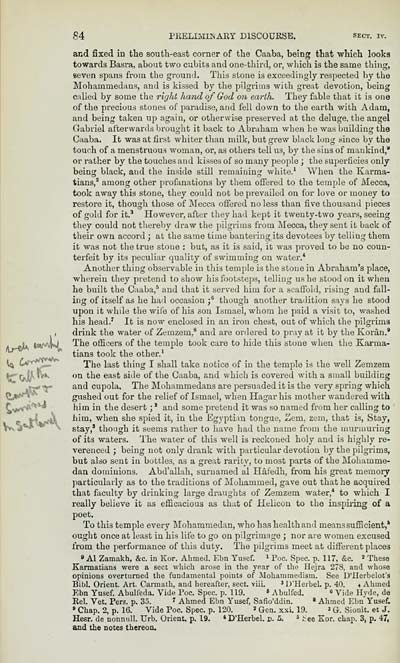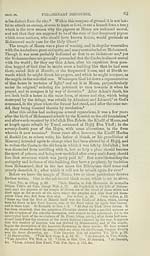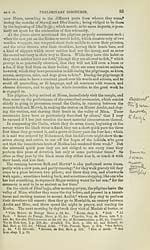Download files
Complete book:
Individual page:
Thumbnail gallery: Grid view | List view

84 PKELIIvLLNARY DISCOUKSB. sect. iv.
and fixed in the south-east corner of the Caaba, being that which looks
towards Basra, about two cubits and one-third, or, which is the same thing,
seven spans from the ground. This stone is exceedingly respected by the
Mohammedans, and is kissed by the pilgrims with great devotion, being
called by some the riyht hand of God on earth. They fable that it is one
of the precious stones of paradise, and fell down to the earth with Adam,
and being taken up again, or otherwise preserved at the deluge, the angel
Gabriel afterwards brought it back to Abraham when he was building the
Caaba. It was at first whiter tlian milk, but grew black long since by the
touch of a menstruous woman, or, as others tell us, by the sins of mankind,*
or rather by the touches and kisses of so many people ; the superficies only
being black, and the inside still remaining white.* When the Karma-
tians,* among other profanations by them offered to the temple of Mecca,
took away this stone, they coidd not be prevailed on for love or money to
restore it, though those of ]\Iecca offered no less than five thousand pieces
of gold for it.' However, after they had kept it twenty-two years, seeing
they could not thereby draw the pilgrims from Mecca, they sent it back of
their own accord ; at the same time bantering its devotees by telling them
it was not the true stone : but, as it is said, it was proved to be no coun-
terfeit by its peculiar quality of swimming on water.*
Another thing observable in this temple is the stone in Abraham's place,
wherein they pretend to show his footsteps, telling us he stood on it when
he built the Caaba,* and that it served him for a scaffold, rising and fiiU-
ing of itself as he ha<l occasion f though another tradition says he stood
upon it while the wife of his son Ismael, whom he paid a visit to, washed
his head.^ It is now enclosed in an iron chest, out of which the pilgrims
, drink the water of Zemzem,* and ai-e ordered to pray at it by the Koran."
_aJU, ♦wtaW The officers of the temple took care to hide this stone when the Karma-
^^"^ ^^^ tians took the other.'
^ Urr^^J^j^ The last thing I shall take notice of in the temple is the well Zemzem
tLToJA'**' on the east side of the Caaba, and which is covered with a small building
T^ -v* and cupola. The Mohammedans are persuaded it is the very spring which
CLA''v' gushed out for the relief of Ismael, when Hagar his mother wandered with
^y<H«^'^*^ him in the desert ; * and some pretend it was so named from her calling to
t4 jrfA him, when she spied it, in the Egyptim tongue, Zem, zem, that is, Stay,
V«va*^ • stay,' though it seems rather to have had the name from the murmuring
of its waters. The water of this well is reckoned holy and is highly re-
verenced ; being not only drank with particular devotion by the pilgrims,
but also sent in bottles, as a great rarity, to most parts of the Mohamme-
dan dominions. Abd'allah, surnamed al Hafedh, from his great memory
particularly as to the traditions of Mohammed, gave out that he acquired
that faculty by drinking large draughts of Zemzem water,* to which I
really believe it as efficacious as that of Helicon to the inspii-ing of a
poet.
To this temple every Mohammedan, who has healthand means sufficient,*
ought once at least in his life to go on pilgrimage ; nor are women excused
from the performance of this duty. The pilgrims meet at different places
» Al Zamakh, &c. in Kor. Ahmed. Ebn Yusef. ^ Poc. Spec. p. 117, &c. * These
Karmatians were a sect which arose in the year of the Hejra 278, and whose
opiaions overturned the fundamental points of Mohammedism. See D'llerbelot's
Bibl. Orient. Art. Carmath, and hereafter, sect. yiii. 'D'Herbel. p. 40. 4 Ahmed
Ebn Yusef. Abulfeda. Vide Poc. Spec. p. 119. « Abulfed. « Vide Hvde, de
Eel. Vet. Pers. p. 35. ^ Ahmed Ebn Yusef, Safio'ddin. » Ahmed Ebn Yusef.
» Chap. 2, p. 16. Vide Poc. Spec. p. 120. » Gen. xxi. 19. ' G. Sionit. et J.
Hesr. de nonnulL Urb. Orient, p. 19. * D'Herbel. c 5. * tee Kor. chap. 3, p. 47,
and the notes thereon.
and fixed in the south-east corner of the Caaba, being that which looks
towards Basra, about two cubits and one-third, or, which is the same thing,
seven spans from the ground. This stone is exceedingly respected by the
Mohammedans, and is kissed by the pilgrims with great devotion, being
called by some the riyht hand of God on earth. They fable that it is one
of the precious stones of paradise, and fell down to the earth with Adam,
and being taken up again, or otherwise preserved at the deluge, the angel
Gabriel afterwards brought it back to Abraham when he was building the
Caaba. It was at first whiter tlian milk, but grew black long since by the
touch of a menstruous woman, or, as others tell us, by the sins of mankind,*
or rather by the touches and kisses of so many people ; the superficies only
being black, and the inside still remaining white.* When the Karma-
tians,* among other profanations by them offered to the temple of Mecca,
took away this stone, they coidd not be prevailed on for love or money to
restore it, though those of ]\Iecca offered no less than five thousand pieces
of gold for it.' However, after they had kept it twenty-two years, seeing
they could not thereby draw the pilgrims from Mecca, they sent it back of
their own accord ; at the same time bantering its devotees by telling them
it was not the true stone : but, as it is said, it was proved to be no coun-
terfeit by its peculiar quality of swimming on water.*
Another thing observable in this temple is the stone in Abraham's place,
wherein they pretend to show his footsteps, telling us he stood on it when
he built the Caaba,* and that it served him for a scaffold, rising and fiiU-
ing of itself as he ha<l occasion f though another tradition says he stood
upon it while the wife of his son Ismael, whom he paid a visit to, washed
his head.^ It is now enclosed in an iron chest, out of which the pilgrims
, drink the water of Zemzem,* and ai-e ordered to pray at it by the Koran."
_aJU, ♦wtaW The officers of the temple took care to hide this stone when the Karma-
^^"^ ^^^ tians took the other.'
^ Urr^^J^j^ The last thing I shall take notice of in the temple is the well Zemzem
tLToJA'**' on the east side of the Caaba, and which is covered with a small building
T^ -v* and cupola. The Mohammedans are persuaded it is the very spring which
CLA''v' gushed out for the relief of Ismael, when Hagar his mother wandered with
^y<H«^'^*^ him in the desert ; * and some pretend it was so named from her calling to
t4 jrfA him, when she spied it, in the Egyptim tongue, Zem, zem, that is, Stay,
V«va*^ • stay,' though it seems rather to have had the name from the murmuring
of its waters. The water of this well is reckoned holy and is highly re-
verenced ; being not only drank with particular devotion by the pilgrims,
but also sent in bottles, as a great rarity, to most parts of the Mohamme-
dan dominions. Abd'allah, surnamed al Hafedh, from his great memory
particularly as to the traditions of Mohammed, gave out that he acquired
that faculty by drinking large draughts of Zemzem water,* to which I
really believe it as efficacious as that of Helicon to the inspii-ing of a
poet.
To this temple every Mohammedan, who has healthand means sufficient,*
ought once at least in his life to go on pilgrimage ; nor are women excused
from the performance of this duty. The pilgrims meet at different places
» Al Zamakh, &c. in Kor. Ahmed. Ebn Yusef. ^ Poc. Spec. p. 117, &c. * These
Karmatians were a sect which arose in the year of the Hejra 278, and whose
opiaions overturned the fundamental points of Mohammedism. See D'llerbelot's
Bibl. Orient. Art. Carmath, and hereafter, sect. yiii. 'D'Herbel. p. 40. 4 Ahmed
Ebn Yusef. Abulfeda. Vide Poc. Spec. p. 119. « Abulfed. « Vide Hvde, de
Eel. Vet. Pers. p. 35. ^ Ahmed Ebn Yusef, Safio'ddin. » Ahmed Ebn Yusef.
» Chap. 2, p. 16. Vide Poc. Spec. p. 120. » Gen. xxi. 19. ' G. Sionit. et J.
Hesr. de nonnulL Urb. Orient, p. 19. * D'Herbel. c 5. * tee Kor. chap. 3, p. 47,
and the notes thereon.
Set display mode to: Large image | Transcription
Images and transcriptions on this page, including medium image downloads, may be used under the Creative Commons Attribution 4.0 International Licence unless otherwise stated. ![]()
| Early Gaelic Book Collections > J. F. Campbell Collection > Koran: or, Alcoran of Mohammed > (106) |
|---|
| Permanent URL | https://digital.nls.uk/77135261 |
|---|
| Description | Volumes from a collection of 610 books rich in Highland folklore, Ossianic literature and other Celtic subjects. Many of the books annotated by John Francis Campbell of Islay, who assembled the collection. |
|---|
| Description | Selected items from five 'Special and Named Printed Collections'. Includes books in Gaelic and other Celtic languages, works about the Gaels, their languages, literature, culture and history. |
|---|

